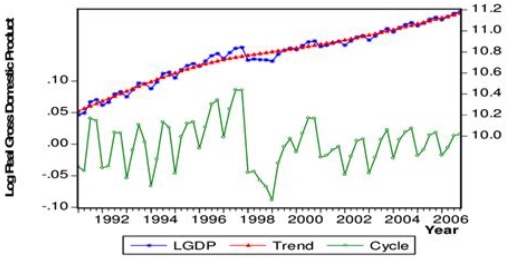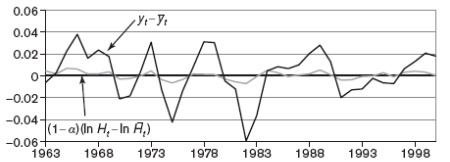26.05.2023 Business Cycle#
Business Cycle: fluctuations found in the aggregate economic activity, consists of contractions and expansions
let \(y_t = \ln Y_t\), \(\bar{y}_t = \ln \bar{Y}_t\), \(c_t = Y_t^c\)
sorted with: Hodrick-Prescott-Filter $$ HP = \underbrace{\sum_{t=1}^T (y_t-\bar{y_t}^2)}_{\text{change in trend}}
\lambda \cdot \underbrace{\sum_{t=2}^{T-1} [(\bar{y}_{t+1} - \bar{y_t}) - (\bar{y}t - \bar{y}{t+1})]} _{\text{cyclical component}} $\( \)\lambda$ = weight of cyclical vs. trend

note: Trend is not always Regression, but fluctuates too! (not single straigt line!)
Stylized Facts#
Volatility#
empirical standard deviation
Stylized Facts of the BC
Real GDP moves up and down over business cycle
Investment is more volative than GDP (most unstable)
aboslute volatility of Inflation = 1/3 of GDP volatility
Correlation#
Remember:
Correlation can be negative / positive
Variables can be leading and lagging
Facts:
Consumption / Investment = positive corr. with GDP
Employment = procyclical (and unempl. vice-versa)
Inflation = positively corr. with GPD (altough not strong!)
Employment / Nominal Interest = lagging variable
Persistence#
Persistence: \(x_t\) is not independent from \(x_{t-n}\)
Variables stay at point, even after others have already changed
Facts:
GDP, Consumption, Investemennt = considerable persistence
Employment = even more pers.
Output Gap#
Difference between real GDP and trend value
negative = recession
Positive = boom

How to calculate? Insane Math…
Facts:
Total Labor Input is procyclical, and so is TFP
variation in labor is due to unemployment, not working hours